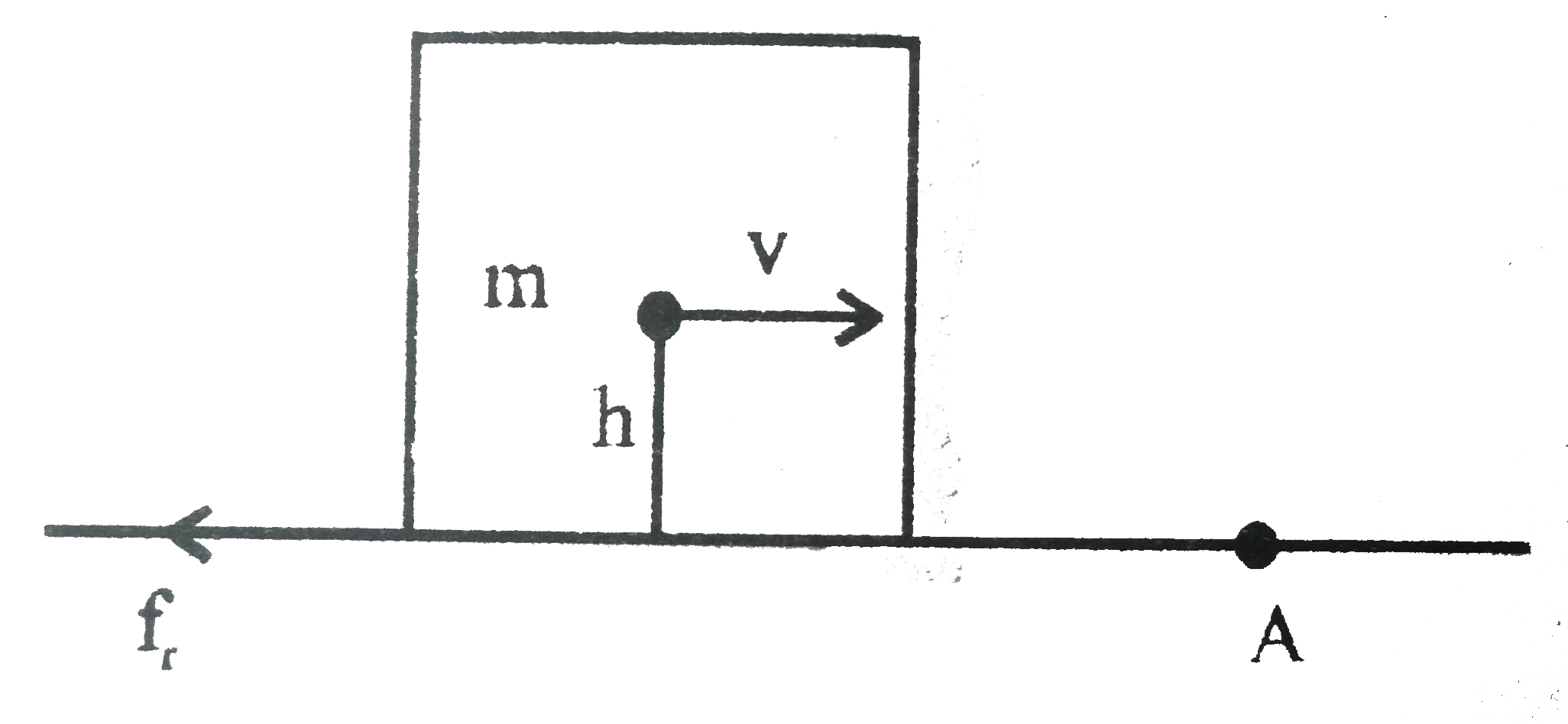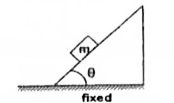A block of mass moves on a horizontal rough surface with initial velocity . The height of the centre of mass of the block is from the surface. Consider a point on the surface.
angular momentum about is initially
the velocity of the block decreases at time passes.
torque of the forces acting on block is zero about
angular momentum is not conserved about .
The correct Answer is:A, B, D

(A) Angular momentum about is initially
(B) Due to friction velocity of block decrease with time
( C) Since angular momentum about decreases so torque of forces is not zero about
(D) Angular momentum is not conserved about .
Similar Questions
Knowledge Check
- Question 1 - Select One
Asseration : A block of mass m starts moving on a rough horizontal surface with a velocity v. It stops due to friction between the block and the surface after moving through a ceratin distance. The surface is now tilted to an angle of 30∘ with the horizontal and same block is made to go up on the surface with the same initial velocity v. The decrease in the mechanical energy in the second situation is small than the first situation.
Reason : The coefficient of friction between the block and the surface decreases with the increase in the angle of inclination.AIf both Assertion and Reason are true and the Reason is correct explanation of the Assertion.BIf both Assertion and Reason are true and the Reason is not the correct explanation of the Assertion.CIf Assertion is true, but the Reason is falseDIf Assertion is false but the Reason is true. - Question 2 - Select One
STATEMENT-1: A block of mass m starts moving on a rough horizontal surface with a velocity v. It stops due to friction between the block and the surface after moving a certain distance. The surface is now tilted to an angle of 30∘ with the horizontal and the same block is made to go up on the surface with the same initial velocity v. The decrease in the mechanical energy in the second situation is smaller than that in the first situation.
because
STATEMENT-2: The coefficient of friction between the block and the surface decreases with the increase in angle of inclination.AStatement-1 is True, Statement-2 is True, Statement-2 is a correct explanation for statement-1.BStatement-1 is True, Statement-2 is True, Statement-2 is NOT a correct explanation for Statement-1.CStatement-1 is True, Statement-2 is False.DStatement-1 is False, Statement-2 is True. - Question 3 - Select One
In the following questions, each question contains Statement I(assertion) and StatementII(reason). Each questions has four choices a, b, c, and d out of which only one is correct.
Statement I: A block of mass m starts moving on a rough horizontal surface with a velocity v. It stops due to friction between the block and the surface after moving through a certain distance. The surface is now titled to an angle of 30∘ with the horizontal and the same block is made to go up on the surface with the same initial velocity v. The decrease in mechanical energy in the second situation is smaller than that in the first situation.
Statement II: The coefficient of friction between the block and the surface decreases with the increase in the angel of inclination.A(a) Statement I is true, Statement II is true, Statement II is a correct explanation for Statement I.B(b) Statement I is true, Statement II is true, Statement II is not a correct explanation for Statement I.C(c) Statement I is true, Statement II is false.D(d) Statement I is false, Statement II is true.
What is the value of applied force ‘F’ which is exerted at an angle θ with the horizontal on a block of mass ‘m’ placed on a horizontal rough surface, if the coefficient of static friction between the block and the surface is , such that the block is on the verge of moving horizontally?
 View Solution
View SolutionA rectangular block is kept on a rough horizontal surface and given some initial velocity. The coefficient of friction between the block and the surface is constant. The block will topple
View SolutionA block of mass 10 kg, moving with acceleration 2m/s2 on horizontal rough surface is shown in figure
 View Solution
View SolutionA uniform cube of mass m and edge a moves on a horizontal surface along the positive x-axis, with initial velocity v0. Then
View SolutionA block of mass m is placed on a rough horizontal surface. If minimum force to pull the block is mg2 then coefficient of friction is :
View Solution



